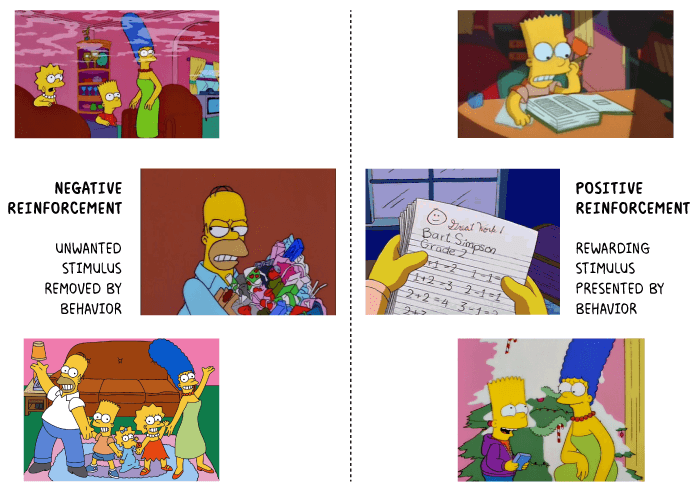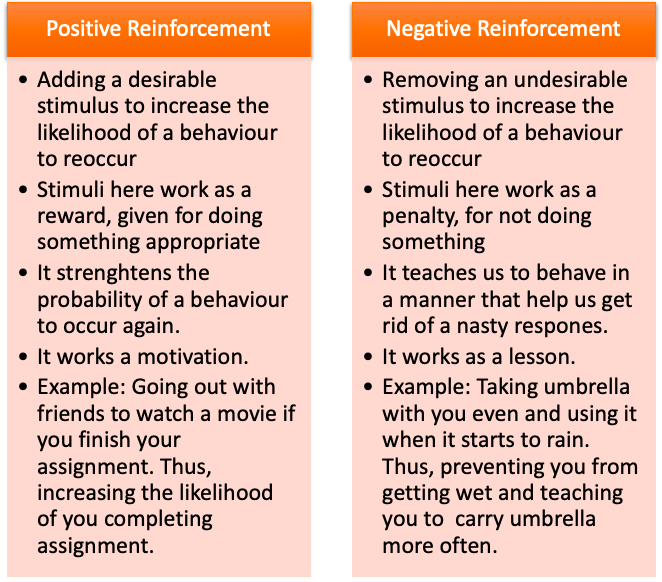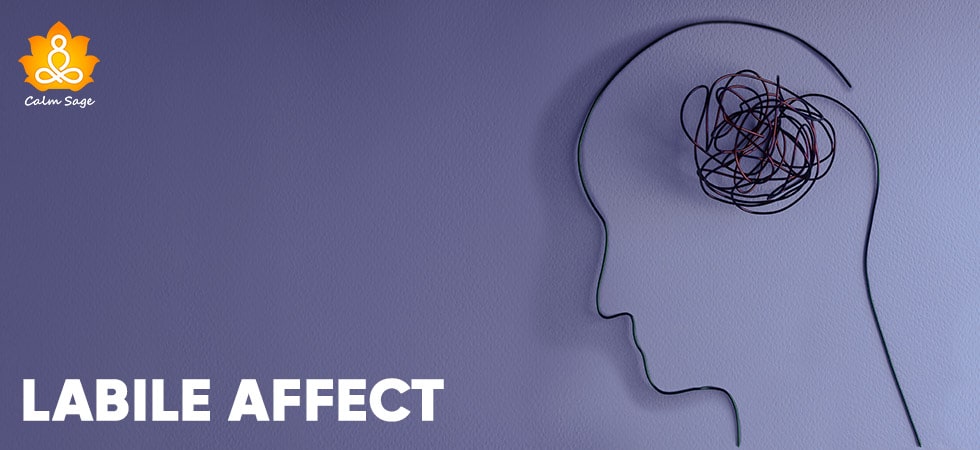Positive vs Negative Reinforcement: Which Is More Effective?

List of Contents
Last week, our company started a healthy competition between us. The winner of the same will be rewarded, with something fancy.
That’s when I realized how productive we ended up being for the given week.
But, why?
Why did this happen?
Why does a reward make us work to our best capabilities and enhance our performance on the task that we have been doing for months and years now?
Well, the answer to all these questions was lying in one word! Reinforcement
But, this one word carries lots of folded concepts within it. So, let us unfold these concepts and understand REINFORCEMENT in detail.
What is Reinforcement?
The concept of reinforcement was given by B.F. Skinner as a part of his learning theory profoundly known as Operant Conditioning. Reinforcement refers to anything that holds the power to increase the likelihood of a response to occur again.
In simpler words, anything that calls forth a response to reoccur is reinforcement. It can be something as small as a candy or as big as a bonus! Reinforcement may be materialistic, like going for a movie night or non-materialistic like words of praise. As long as it is strengthening a response, increasing its chances to reoccur, and has the element of tangible rewards, situations, and events attached to it, it is reinforcement.
What are the Different Types of Reinforcement?
By and large, the reinforcements can be of two types viz.,
Positive Reinforcement:
It involves adding a rewarding stimulus in order to increase a positive behavior/likelihood of a particular behavior to occur again.
Negative Reinforcement:
It involves reducing an aversive stimulus in order to increase a positive behavior/likelihood of a behavior to occur again.
Note: Often negative reinforcement is confused with punishment. However, it is important to understand that this is not the case. Negative reinforcement increases the likelihood of behavior, whereas, punishment decreases it.

Read More: Left Brain vs Right Brain : What’s The Difference?
Examples of Positive and Negative Reinforcement:
Definitions can be little confusing, therefore, le us understand how positive and negative reinforcement works with a quick examples:

Example I:
A mother who wishes to reduce the TV time for her child.
Now applying the two REINFORCEMENTs here to increase the likelihood of the desired behavior that is- Reduced TV time.
Positive Reinforcement: Rewarding the child with his favorite food for sticking to the time allotted to him to watch TV
Here: The child will limit his TV hours because he is motivated to get his favorite food.
Negative Reinforcement: Showing a child a video of adverse effects of spending too much time on screen, say getting specs.
Here: To avoid the penalty of wearing specs the child will limit his TV hours.
Thus, both reinforcements are increasing the chances of the desired behavior (reduced TV time) to reoccur.
Example II:
An HR who wishes to increase productivity among employees
Now applying the two REINFORCEMENTs here to increase the likelihood of the desired behavior that is- Increased Productivity.
Positive Reinforcement: Rewarding the employees who reach the given target with extra paid leaves.
Here: The employee will work towards the target as he is motivated to get more paid leaves.
Negative Reinforcement: Reducing office noise and interference in privacy by giving more space to employees i.e., reducing crowding and offering more open space, if the targets are met and productivity is increased.
Here: To avoid the crowd, noises, and privacy invasion, the employees will work towards achieving the targets. Hence, productivity is increased.
Thus, both reinforcements are increasing the chances of the desired behavior (Increased Productivity).
Read More: What is PAWS? Read About Its Symptoms
Positive vs Negative Reinforcement: Which is The Best and Why?
Depending on the requirement of behavior modification both reinforcements work equally well, be it positive reinforcement or negative reinforcement. Here is a table for you to refer to understand the difference between positive and negative reinforcement

Positive Reinforcement vs Negative Reinforcement
With the help of this table, one point Positive Reinforcement vs Negative Reinforcement can be made clear that it is not positive vs negative reinforcement, rather it is positive and negative reinforcement. To put it into simpler words, it is all about striking the right balance between these two reinforcements to get the best outcomes.
How to Plan Reinforcement?
If reinforcement is given without a proper plan or in an offhand manner then the effect of it might decrease. Therefore, it is important that reinforcement is scheduled, be it positive or negative. To plan reinforcement two important dimensions have to be considered, viz., Time, and Responses.
1. Fixed-ratio schedules:
Reinforcing a behavior after a specific number of responses have occurred.
Example: If the employee sells 10 passes he gets a bonus.
2. Fixed-interval schedules:
Reinforcing a behavior after a specific period of time has elapsed.
Example: If the child studies for 1 hour, let him play his favorite game for the next 15 minutes.
3. Variable-ratio schedules:
Reinforcing the behavior after an unpredictable number of responses.
Example: If the employee sells 10 passes he gets a bonus. The next bonus is granted by selling 5 passes, followed by 15 passes, 20 passes, 10 passes, so on and so forth.
4. Variable-interval schedules:
Reinforcing the behavior after an unpredictable period of time has elapsed.
Example: If the child studies for 30 minutes, let him play his favorite game for the next 15 minutes. Then, the child has to study for 45 minutes to get his playtime. Next, a playtime break comes after 1h 15min of studies. So on and so forth.
Note: Continuous reinforcement works best if the behavior is new to learning, after which scheduling of reinforcement is recommended.
Example: Clapping (positive reinforcement) each time the infant walks without support (continuous reinforcement). Then, clapping only if the child walks for one 1-minute without support or two times (scheduling).
In Which Settings Reinforcement Can be Applied?
Ideally, tried in the lab and applied to animals, a reinforcement now can be applied to humans in real-life settings. Reinforcement, be it positive or negative has an impact on our behavior and learning outcomes. Therefore, it can be applied to numerous settings to get favorable outcomes (positive reinforcement) or avoid unfavorable conditions (negative reinforcement).
1. Self.
To modify our own behavior or to motivate ourselves to work with the best of our abilities we can make use of reinforcement.
2. Development.
During the developmental age, reinforcement plays an important role. It helps an infant to build behavior that will be reflected in his/her personality.
3. Learning.
Classroom settings or home tuitions, reinforcement plays an important role in learning. Not to forget the origin of positive and negative reinforcement comes from learning theory itself. It works well in motivating kids to
4. Work Environment.
It can be used in an office setup to acknowledge and encourage the desired behavior. In fact, we began our write-up with the reinforcement being applied at the workplace.
So, if the next time deadline haunts you, instead of running away from it, set a positive reinforcement for yourself (watching a web series) and work towards it.
Also, now that you know what REINFORCEMENT is and the use of negative and positive reinforcement time to apply the same in your life and bring behavioral changes.
P.S. make sure you reinforce the right behavior to get the outcomes that are indeed required.
You May Like These Also:
1. Best Foods That Help To Reduce Anxiety
2. Step Into The Light- Acceptance Is The Key
3. Change Your Mindset And Reduce Anxiety





















Indeed, a well-written and explained article! Keep up the good work :)
Thank you so much for your kind words of motivation.